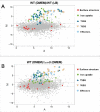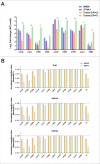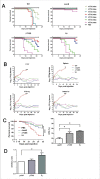Transcriptomic dissection of the horizontally acquired response regulator EsrB reveals its global regulatory roles in the physiological adaptation and activation of T3SS and the cognate effector repertoire in Edwardsiella piscicida during infection toward turbot
- PMID: 28441105
- PMCID: PMC5711410
- DOI: 10.1080/21505594.2017.1323157
Transcriptomic dissection of the horizontally acquired response regulator EsrB reveals its global regulatory roles in the physiological adaptation and activation of T3SS and the cognate effector repertoire in Edwardsiella piscicida during infection toward turbot
Abstract
Edwardsiella piscicida is the leading pathogen threatening worldwide aquaculture industries. The 2-component system (TCS) EsrA-EsrB is essential for the pathogenesis of this bacterium. However, little is known about the regulon and regulatory mechanism of EsrA-EsrB or about the factors that mediate the interaction of TCS with bacterial hosts. Here, our RNA-seq analysis indicated that EsrB strongly induces type III and type VI secretion systems (T3/T6SS) expression and that it modulates the expression of both physiology- and virulence-associated genes in E. piscicida grown in DMEM. EsrB binds directly to a highly conserved 18-bp DNA motif to regulate the expression of T3SS and other genes. EsrB/DMEM-activated genes include 3 known and 6 novel T3SS-dependent effectors. All these effector genes are highly induced by EsrB during the late stage of in vivo infection in fish. Furthermore, although in vivo colonization by the bacterium relies on EsrB and T3/T6SS expression, it does not require the expression of individual effectors other than EseJ. The mutant lacking these 9 effectors showed significant defects in in vivo colonization and virulence toward turbot, and, more importantly, a high level of protection against challenges by wild-type E. piscicida, suggesting that it may represent a promising live attenuated vaccine. Taken together, our data demonstrate that EsrB plays a global regulatory role in controlling physiologic responses and the expression of T3SS and its cognate effector genes. Our findings will facilitate further work on the mechanism of molecular pathogenesis of this bacterium during infection.
Keywords: Edwardsiella piscicida; EsrB; RNA-seq; T3SS; T6SS; effectors.
Figures








Comment in
-
Virulence regulation during late infection by a fish pathogen; sense and sensibility of bacteria may lead to novel vaccine development strategy.Virulence. 2017 Oct 3;8(7):1096-1098. doi: 10.1080/21505594.2017.1344807. Epub 2017 Jun 22. Virulence. 2017. PMID: 28641041 Free PMC article. No abstract available.
Similar articles
-
EsrB negatively regulates expression of the glutamine sythetase GlnA in the fish pathogen Edwardsiella piscicida.FEMS Microbiol Lett. 2018 Feb 1;365(4). doi: 10.1093/femsle/fny007. FEMS Microbiol Lett. 2018. PMID: 29346648
-
PepA binds to and negatively regulates esrB to control virulence in the fish pathogen Edwardsiella piscicida.Microbiol Res. 2020 Feb;232:126349. doi: 10.1016/j.micres.2019.126349. Epub 2019 Oct 9. Microbiol Res. 2020. PMID: 31816594
-
Balanced role of T3SS and T6SS in contribution to the full virulence of Edwardsiella piscicida.Fish Shellfish Immunol. 2019 Oct;93:871-878. doi: 10.1016/j.fsi.2019.08.014. Epub 2019 Aug 7. Fish Shellfish Immunol. 2019. PMID: 31400510
-
Edwardsiella piscicida: A versatile emerging pathogen of fish.Virulence. 2019 Dec;10(1):555-567. doi: 10.1080/21505594.2019.1621648. Virulence. 2019. PMID: 31122125 Free PMC article. Review.
-
Antitoxin HigA orchestrates T3SS/T6SS expression in aquatic pathogen Edwardsiella piscicida.Microbiol Res. 2025 Nov;300:128281. doi: 10.1016/j.micres.2025.128281. Epub 2025 Jul 17. Microbiol Res. 2025. PMID: 40684687 Review.
Cited by
-
Xenogeneic nucleoid-associated EnrR thwarts H-NS silencing of bacterial virulence with unique DNA binding.Nucleic Acids Res. 2022 Apr 22;50(7):3777-3798. doi: 10.1093/nar/gkac180. Nucleic Acids Res. 2022. PMID: 35325196 Free PMC article.
-
Comparative genomics of the fish pathogens Edwardsiella ictaluri 93-146 and Edwardsiella piscicida C07-087.Microb Genom. 2020 Feb;6(2):e000322. doi: 10.1099/mgen.0.000322. Microb Genom. 2020. PMID: 32108566 Free PMC article.
-
Type III secretion system effector YfiD inhibits the activation of host poly(ADP-ribose) polymerase-1 to promote bacterial infection.Commun Biol. 2024 Feb 9;7(1):162. doi: 10.1038/s42003-024-05852-z. Commun Biol. 2024. PMID: 38332126 Free PMC article.
-
ChIP-seq and structural analyses delineating the regulatory mechanism of master regulator EsrB in Edwardsiella piscicida.Appl Environ Microbiol. 2024 Dec 18;90(12):e0180524. doi: 10.1128/aem.01805-24. Epub 2024 Nov 15. Appl Environ Microbiol. 2024. PMID: 39545739 Free PMC article.
-
A Bacterial Pathogen Senses Host Mannose to Coordinate Virulence.iScience. 2019 Oct 25;20:310-323. doi: 10.1016/j.isci.2019.09.028. Epub 2019 Sep 25. iScience. 2019. PMID: 31605945 Free PMC article.
References
-
- Stock AM, Robinson VL, Goudreau PN. Two-component signal transduction. Annu Rev Biochem 2000; 69:183-215; PMID:10966457; https://doi.org/10.1146/annurev.biochem.69.1.183 - DOI - PubMed
-
- Mitrophanov AY, Groisman EA. Signal integration in bacterial two-component regulatory systems. Genes Dev 2008; 22(19):2601-11; PMID:18832064; https://doi.org/10.1101/gad.1700308 - DOI - PMC - PubMed
-
- Li L, Wang Q, Zhang H, Yang M, Khan MI, Zhou X. Sensor histidine kinase is a beta-lactam receptor and induces resistance to beta-lactam antibiotics. Proc Natl Acad Sci U S A 2016; 113(6):1648-53; PMID:26831117; https://doi.org/10.1073/pnas.1520300113 - DOI - PMC - PubMed
-
- Rasko DA, Moreira CG, Li DR, Reading NC, Ritchie JM, Waldor MK, Williams N, Taussig R, Wei S, Roth M. Targeting QseC signaling and virulence for antibiotic development. Science 2008; 321(5892):1078-80; PMID:18719281; https://doi.org/10.1126/science.1160354 - DOI - PMC - PubMed
-
- Wang Q, Yang M, Xiao J, Wu H, Wang X, Lv Y, Xu L, Zheng H, Wang S, Zhao G. Genome sequence of the versatile fish pathogen Edwardsiella tarda provides insights into its adaptation to broad host ranges and intracellular niches. PLoS One 2009; 4(10):e7646; PMID:19865481; https://doi.org/10.1371/journal.pone.0007646 - DOI - PMC - PubMed
Publication types
MeSH terms
Substances
Grants and funding
LinkOut - more resources
Full Text Sources
Other Literature Sources
